Report to the Community
At Cedars-Sinai, everything we accomplished in 2022-23 supported one overarching goal: fulfilling our deep and abiding commitment to improving the lives of our patients and the health status of the communities we serve. We remain steadfast in our efforts to enhance quality of life through nurturing the health of the most vulnerable, eliminating disparities in treatments and patient outcomes, pioneering innovative medical research, and training new generations of scientists and clinicians. Our growth over the past year reflects these institutional values and is grounded in our dedication to our community.
Key Volumes and Other Statistics
July 1, 2022–June 30, 2023

1,048*
Licensed Beds

321,499*
Patient Days

1,850,022*
Outpatient Visits

50,400*
Admissions
125,087*
Emergency Visits

15,245*
Full-Time Employees

2,847**
Physicians on Medical Staff

165,552
Hours Donated
by 3,415 Volunteers

526
Clinical Trials
2,300+
Peer-Reviewed Faculty Publications

$158+ Million in Federal Awards
386 Total Grants Received

$261+ Million
in Research Expenses
2,200+ Research Projects

249
Postdoctoral Scholars
72 PhD and MS Students

$1,117,371,000
Contribution for Community Benefit

$20 Million
in Grants and Sponsorships Awarded to L.A. Nonprofit Organizations

$179,779,098
Philanthropic Dollars Raised

11,014
New and Renewed Donors
*Cedars-Sinai Medical Center + Cedars-Sinai Marina del Rey Hospital + Cedars-Sinai Medical Network
**Cedars-Sinai Medical Center + Cedars-Sinai Marina del Rey Hospital
†The NIH fiscal year ran from Oct. 1, 2022, through Sept. 30, 2023.
Areas of Impact
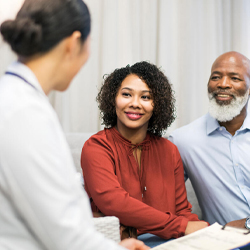
The Smidt Heart Institute at Cedars-Sinai is home to one of the largest cardiothoracic transplant surgery programs in California and the nation.
The Smidt Heart Institute was also named a Mitral Valve Repair Reference Center, a recognition awarded to select U.S. medical centers with a record of superior clinical outcomes.
The Cedars-Sinai Geriatric Fracture Program reduced the length of hospital stays for older adults with bone fractures and evaluated these patients for bone health and fall prevention. The program is helping people remain independent longer and offers a replicable model for other health systems.
The Cedars-Sinai Comprehensive Transplant Center and Smidt Heart Institute teams completed a record 616 solid organ transplants, an 11% increase from last year’s high of 556. We also completed our first successful triple transplant—heart, liver and kidney.
The Guerin Family Congenital Heart Program earned accreditation from the Adult Congenital Heart Association, signifying an association with better patient outcomes and a clinical team that provides comprehensive expertise for complex congenital heart conditions requiring lifelong care.
Patients now have 24/7 virtual access to acute, chronic and preventive care experts and can make same-day appointments for primary care visits through a new healthcare app, Cedars-Sinai Connect.
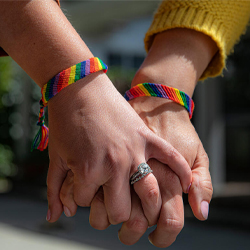
In FY23, Cedars-Sinai awarded over $20 million in grants and sponsorships to more than 200 groups working to improve access to care, strengthen community-based organizations and address the challenge of homelessness in our local community. One significant investment involved $2.2 million in grants to 12 organizations focused on Black birth equity.
Our five signature community programs grew to nearly 55,000 encounters as worries about the COVID-19 pandemic abated. Aid provided by the programs included in-school mental health services through our Share & Care program, pediatric care in our COACH for Kids mobile medical unit, and COVID-19 and flu vaccines across the community.
More than 3,000 volunteers, ranging from teenagers to retirees, returned to Cedars-Sinai this year after a pandemic hiatus—with a dramatic increase in young adults exploring the medical field as part of their career planning and preparation. More than 400 of our current 15,000 employees started out as volunteers at the medical center.
We hosted Embracing Our Community Live town halls to share information on a range of important issues affecting historically underrepresented communities. Our experts teamed up with partners in the community to explore subjects such as accessing clinical trials, prepping children for a healthy school year, understanding lung cancer and navigating Medicare enrollment. We partnered with the group BlackDoctor.org for some of these events, including one that addressed Black maternal health and shared resources and information on how to reduce persistent inequities in birth experiences and outcomes.
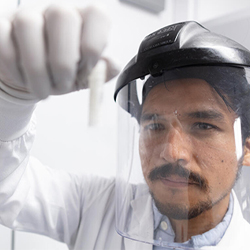
With a five-year $11.2 million National Cancer Institute grant, Cedars-Sinai Cancer investigators intensified their research on how biological differences between men and women affect bladder cancer, with the goal of shaping therapies to improve patient outcomes.
Neurosurgeons at Cedars-Sinai identified an immune cell subtype in the retina that is linked to changes caused by Alzheimer’s disease—and potentially numerous eye disorders.
A first-of-its-kind stem cell therapy for amyotrophic lateral sclerosis (ALS) passed a critical safety benchmark, advancing the quest to slow down and hopefully reverse the fatal neurological disorder.
A study by investigators in the Cedars-Sinai Department of Obstetrics and Gynecology found that Black and Latina patients are significantly less likely than white patients to undergo minimally invasive surgery for uterine fibroids. Further research is ongoing to identify pathways for all women to have equal access to high-quality, evidence-based care.
Cedars-Sinai investigators used stem cell technology to repair and regenerate damaged bone and tendon tissues, which has the potential to dramatically alter patient outcomes.
New analyses from the Smidt Heart Institute found that deaths from heart attacks rose during COVID-19 surges—most significantly for those who are between 25 and 44 years old—reversing a pre-pandemic trend of declining deaths due to cardiac arrests.
A blood test discovered by Cedars-Sinai investigators can now identify pregnant women at risk of developing the life-threatening blood pressure disorder preeclampsia. The test has been approved by the U.S. Food and Drug Administration.
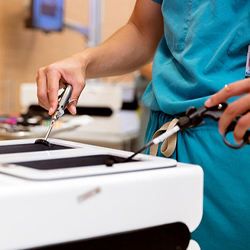
Graduate school enrollment in our Master’s in Health Delivery Science, Master’s in Magnetic Resonance in Medicine and PhD programs continues to grow. Twenty-nine students graduated from these programs in FY23.
Our new Diversity, Equity and Inclusion Ambassadors program engaged residents from historically marginalized groups through mentorship, outreach and education. In FY23, more than 100 applicants vied for each available residency spot at Cedars-Sinai, and we interviewed the most diverse group of candidates ever.
The Women’s Guild Simulation Center for Advanced Clinical Skills celebrated its 10th anniversary. Over the past decade, the center has helped 150,000 health professionals—and thousands of students—learn new techniques, improve existing practices and heighten team performance. More than 1,000 people train in the center each month.
The innovative Diversity, Equity and Inclusion Transition to Practice Program at Cedars-Sinai supported promising nurses who have experience, but not in an inpatient setting. The program has provided mentorship to more than 30 nurses to date, advancing them to new levels of expertise while also helping to address a national nursing shortage.
Eighty-four percent of neurosurgery residency applicants in the U.S. applied for one of two spots available at Cedars-Sinai, while 502 applicants sought one of our five neurology residency slots.
Cedars-Sinai faculty provided extensive, highly competitive medical training programs for physicians and health professionals in 88 specialty and subspecialty areas. New programs in pediatrics and neurocritical care were approved by the Accreditation Council for Graduate Medical Education (ACGME).

Cedars-Sinai is harnessing artificial intelligence (AI) to enhance patient care, improve efficiency and advance scientific discovery. To further these efforts, we created a new Artificial Intelligence Council and the Center for Artificial Intelligence Research and Education. Other innovations that were unveiled included a new AI tool to predict adverse cardiac events like heart attacks and a game-changing smartphone app that uses AI to help assess and manage digestive diseases such as irritable bowel syndrome.
The Cedars-Sinai Board of Governors Innovation Center opened in fall 2022. It is dedicated to single-cell genomic and cellular analyses of diseases.
Prometheus Biosciences—a startup founded to license Cedars-Sinai’s intellectual property for inflammatory bowel disease therapeutic development—was acquired by Merck for $10.8 billion, of which Cedars-Sinai received $899.3 million.
Cedars-Sinai’s Technology Ventures Program continued to transform science into medical breakthroughs. The program’s technologies yielded 123 patents in FY23. Net income, which totaled $13.2 million in 2023, is reinvested in research.
We launched the Cedars-Sinai Virtual Second Opinion service to connect individuals in need of complex cardiac, spine or gynecologic care with top-ranked experts for customized treatment options and virtual education sessions. Now available in more than half the states in the country, the online platform is expected to add specialties and expand geographically in FY24.

Visionary philanthropists provided essential support to help educate diverse future generations of health professionals. A new school of allied health is being established at Cedars-Sinai to train people from groups that historically have been economically and socially marginalized for roles in six chronically understaffed areas, including respiratory therapy and radiologic technology. Another donor has increased funding for a neurosciences program that mentors students from historically Black colleges and universities.
Recognizing that the Cedars-Sinai Emergency Department is always there for patients and families in times of urgent need, numerous donors stepped forward over the past fiscal year to support the department’s hardworking clinical teams.
Donor generosity helped our nurses lead innovative research projects and augment their skills as they continued to provide excellent care to our community.
Supporters fueled our work to meet the urgent needs of our diverse community, including the most vulnerable among us.
The Jewish philosophy of tzedakah—and similar traditions of charitable giving in other religions—inspired many donors to entrust us with anonymous, unrestricted gifts, while others included Cedars-Sinai in their estate plans. This gave us the flexibility to support capital infrastructure and to allocate resources where they’re needed most to fulfill our mission.

To provide care closer to home for our growing community of patients, we extended our footprint in FY23 to 50 locations across the region, a 25% increase from 40 locations in FY22.
To better serve those in the LGBTQIA+ community, Cedars-Sinai opened a new LGBTQ+ Center, which offers multiple specialties in a culturally sensitive environment.
Those who live or work in the beach cities and surrounding neighborhoods now have access to 30 physicians providing urgent, primary and specialty care services with the FY23 expansion of the El Segundo medical complex of Torrance Memorial, a Cedars-Sinai affiliate. In addition, Cedars-Sinai Marina del Rey Hospital laid the foundation for a new, technologically advanced nine-story hospital that is scheduled to open in 2026.
To enhance and increase local access to expert care in Pasadena and the San Gabriel Valley, Huntington Health, a Cedars-Sinai affiliate, added numerous highly respected local physicians in areas such as cancer; cardiac, vascular and thoracic surgery; OB-GYN care; ear, nose and throat; and pediatric subspecialty services.
We expanded the availability of diagnostic imaging services through our joint venture with RadNet to identify and support patients across multiple communities who have been diagnosed with or are at high risk of developing breast cancer.
To bring excellence in healthcare to patients around the globe, we launched Cedars-Sinai’s first collaboration in Latin America; opened The View Hospital in Doha, Qatar, with affiliate Elegancia Healthcare; and further extended our international presence through partnerships in the Middle East, China, Mexico and beyond.
We launched a new joint venture with Tia, a women’s healthcare startup, to create a new standard of care that embraces “whole woman, whole life” care while improving access to health services for young women from historically marginalized groups across Los Angeles.
Patients in the San Fernando Valley now have access to a new patient tower at Providence Cedars-Sinai Tarzana Medical Center. The 200,000-square-foot building features 150 spacious and private patient rooms, an emergency department with double the capacity of the former unit, a new pharmacy, a cardiovascular unit, a critical care unit, and a pediatric unit with a playroom for younger patients and dedicated space for adolescent patients.
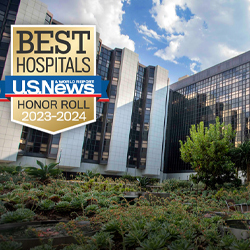
Cedars-Sinai was named to the Honor Roll for the eighth consecutive year and tied for #1 in California in U.S. News & World Report’s “Best Hospitals 2023–24” rankings—a reflection of our firm commitment to providing the highest-quality care to our patients.
The Centers for Medicare and Medicaid Services awarded Cedars-Sinai Medical Center a five-star hospital rating—the highest distinction from the federal agency. This is the sixth consecutive time that Cedars-Sinai has been recognized as one of the hospitals providing patients with the best care in the U.S.
We earned a sixth consecutive Magnet designation for nursing excellence in patient care, maintaining one of the longest-running Magnet designations in the nation and becoming the first hospital in Southern California to sustain this distinction for 23 years in a row.
Two Cedars-Sinai physician organizations—Cedars-Sinai Medical Group and Cedars-Sinai Health Associates—earned the highest honor bestowed by the Integrated Healthcare Association for demonstrating exceptional outcomes in quality, cost and patient experience.
Cedars-Sinai ranked eighth in National Institutes of Health (NIH) funding among independent nonuniversity hospitals, with NIH awards totaling $158+ million.
Community Benefit Contribution
Community Benefit Snapshot |
|
|---|---|
|
July 1, 2022 - June 30, 2023 |
|
|
Unreimbursed cost of direct medical care for the poor and underserved (excludes the unreimbursed cost of caring for Medicare patients)
|
$211,574,000 |
|
Unreimbursed cost of direct medical care for Medicare patients |
$612,303,000 |
|
Unreimbursed cost of caring for patients in specialty government programs |
$5,628,000 |
|
Community Benefit programs, charitable contributions, and education and training for physicians and other health professionals (includes hundreds of free community education and medical screening/immunization programs offered at the medical center and in local schools, homeless shelters and community centers) |
$161,373,000 |
|
Research programs
|
$126,493,000 |
|
Total quantifiable community benefit |
$1,117,371,000 |
Message
“Our dedicated physicians, nurses and staff—and our generous donors, who provide essential support—enable Cedars-Sinai to deliver on our mission to advance scientific knowledge, address the needs of the populations we serve, and enhance the quality of life for our patients, our community and beyond.”
Chair, Board of Directors
President and CEO


